Intel Architecture Day 2021: Alder Lake, Golden Cove, and Gracemont Detailed
by Dr. Ian Cutress & Andrei Frumusanu on August 19, 2021 9:00 AM ESTGolden Cove Microarchitecture (P-Core) Examined
Section by Andrei Frumusanu
Within Alder Lake and Sapphire Rapids, we find Intel’s brand-new performance core (P-Core) microarchitecture, called Golden Cove. The new microarchitecture and core design follows the Willow Cove core in Tiger Lake, the Sunny Cove core in Ice Lake, and the derivative Cypress Cove core in Rocket Lake.
Although the new design is a follow-up over the last few years of core microarchitectures, Intel sees the Golden Gove as a major step-function update, with massive revamps of the fundamental building blocks of the CPU, going as far as calling it as allowing performance for the next decade of compute, meaning Intel is seemingly planning on using it as the basis for the evolution of cores for at least a few years.
The last time we had seen major upgrades to Intel’s core front-end was in Ice Lake's Sunny Cove, making notable increases in the microarchitecture’s out-of-order execution capabilities and depth, while Willow Cove and Cypress Cove were more iterative designs focusing on the memory subsystem.
Golden Cove, in comparison, makes gigantic changes to the microarchitecture’s front-end – in fact, Intel states that this is the largest microarchitectural upgrade in the core family in a decade, mirroring similar changes in magnitude to what Skylake had done many years ago.
Starting off with the directly most obvious change: Intel is moving from being a 4-wide decode machine to being a 6-wide microarchitecture, a first amongst x86 designs, and a major design focus point. Over the last few years there had been a discussion point about decoder widths and the nature of x86’s variable length instruction set, making it difficult to design decoders that would go wider, compared to say a fixed instruction set ISA like Arm’s, where adding decoders is relatively easier to do. Notably last year AMD’s Mike Clarke had noted while it’s not a fundamental limitation, going for decoders larger than 4 instructions can create practical drawbacks, as the added complexity, and most importantly, added pipeline stages. For Golden Cove, Intel has decided to push forward with these changes, and a compromise that had to be made is that the design now adds an additional stage to the mispredict penalty of the microarchitecture, so the best-case would go up from 16 cycles to 17 cycles. We asked if there was still a kind of special-case decoder layout as in previous generations (such as the 1 complex + 3 simple decoder setup), however the company wouldn’t dwell deeper into the details at this point in time. To feed the decoder, the fetch bandwidth going into it has been doubled from 16 bytes per cycle to 32 bytes per cycle.
Intel states that the decoder is clock-gated 80% of the time, instead relying on the µOP cache. This has also seen extremely large changes this generation: first of all, the structure has now almost doubled from 2.25K entries to 4K entries, mimicking a similar large increase we had seen with the move from AMD’s Zen to Zen2, increasing the hit-rate and further avoiding going the route of the more costly decoders.
Although the I-cache has remained the same in terms of size at 32KB, Intel has improved latencies for larger code coverage by increasing the L1 iTLB from 128 entries to 256 entries (16 -> 32 for 2M/4M hugepages).
Because the general misprediction penalty has gone up this generation, Intel is very much counter-acting this by massively improving branch prediction accuracy. First of all, the L2 BTB (branch target buffer) has grown to well over double with the structure increased from 5K entries to 12K entries, making this by far the biggest in the industry that we’re aware of (Zen3: 6.5K, Cortex-A77+: 8K, Apple: ?). It is also said that the branch predictors themselves are now smarter, with their accuracy being improved, although these are always quite a bit secretive in terms of their designs so we didn’t have too many details divulged.
The decoders and the µOP cache feed a µOP queue – beyond he 50% larger decoder width, the µOP cache also now sees an increased bandwidth and able to emit 8 µOPs instead of 6. The µOP queue itself has seen a structural change, for single threads (only one SMT logical core is loaded), the structure can be aggregated and the usable depth has doubled from 70 entries to 144 entries, while for dual threads, has gone up slightly from 70 to 72 entries per thread.
In the mid-core, there’s also been quite large changes. The core here increases from 5-wide to 6-wide, meaning that in theory it should still be a maximum 6 IPC microarchitecture, though we’re talking about µOPs here and not actual instructions.
Intel is noting that they’re doing an increased amount of dependency resolution at the allocation stage, actually eliminating instructions that otherwise would have to actually emitted to the back-end execution resources. Intel here didn’t want to elaborate a lot, only stating that this capability has increased quite a lot generation over generation.
The out-of-order instruction window of Golden Cove is massively larger than Sunny Cove – increasing the re-order buffer (ROB) size from 352 to 512 entries. This is over double that of AMD’s Zen3 µarch, and really only second to Apple’s core microarchitecture which we’ve measured in at around 630 instructions. Traditionally, we’ve always been told that increasing the ROB has diminishing effects and always corelates with quite an increase in power consumption – but on the other hand we saw Apple achieve extremely high OOO-windows. It’s not clear how exactly Intel managed to increase their µarch by such a large degree in a single jump, but it’s a very impressive and admittedly unexpected design characteristic of the Golden Cove cores.
Moving onto the back-end, Intel has increased their execution width from 10 ports to 12 ports. Intel still continues to use merged execution port / reservation station design that characterises their cores in contrast to other µarchs from the competition, or even their own E-core microarchitectures, which use separate integer and FP/vector ports and pipelines.
On the integer side of things, there’s now a fifth execution port and pipeline with simple ALU and LEA capabilities, which in theory makes this the widest x86 core in raw ALU throughput, although in mixed code the 5 pipelines are still somewhat comparatively narrower.
On the FP capabilities side of things, we’ve seen added dedicated FADD capabilities, which are far more efficient and lower latency than using the FMA units (when applicable). The FMA units now have also seen added support for FP16 data types, although this falls under the AVX512 umbrella consumer cores won’t see the capabilities.
In general, besides the added 5th ALU port/pipeline, the back-end execution resources of Golden Cove appear to be somewhat more conservative compared to the more substantial front-end changes of the core.
On the load & store front, we see the addition of an additional dedicated execution port with a load AGU, increasing the possible number of loads per cycle from 2 to 3, matching the upgrades we’ve seen from many other microarchitectures over the last few years.
For AVX512-enabled implementations of the µarch, it’s able to load up to 1Kb/cycle from the L1, while consumer cores still see a 50% improvement for AVX2 256-bit loads with 3 per cycle.
Intel, like many other, have noted that modern workloads have increased memory level parallelism, so they have increased the outstanding memory transactions from the core by increasing the L1D fill buffers from 12 to 16, and increasing the load and store buffers by undisclosed amounts. Similarly, to AMD, to better address sparse memory access workloads, the µarch has seen a doubling of page walkers from 2 to 4, able to look up pages in TLB misses.
The L1 DTLB has grown from 64 entries to 96 entries – Intel didn’t mention the L2 TLB which would mean it’s still at 2048 entries.
Intel has improved the prefetchers, nothing things such as “better stride prefetching in L1”, though beyond that the company hasn’t divulged much other details. We’ve seen a lot of advances in the industry in terms of prefetchers so it’ll be interesting to see how Golden Cove compared to the competition here.
The L2 cache in Golden Cove remains at 1.25MB for consumer core variants, while the server variant grows it to 2MB compared to 1.25MB in the current Ice Lake-SP chips. Parallel data access outstanding requests for the memory subsystem has grown from 32 misses to 48, also further helping with increasing MLP capabilities of the core.
Intel also again notes there’s been prefetching improvements in the L2. What the company calls “full-line-write predictive bandwidth optimisation” is likely the same mechanism we saw in our review of Ice Lake-SP where the core can greatly improve bandwidth by avoiding RFO reads of cache lines that are going to be fully rewritten, which should greatly improve common generic operations such as memory copies.
The aggregated changes of the new Golden Cove microarchitecture amount to a geomean IPC increase of 19% compared to Cypress Cove (Rocket Lake) - measured over a set of workloads including SPEC CPU 2017, SYSmark 25, Crossmark, PCMark 10, WebXPRT3, and Geekbench 5.4.1. We can see in the graph that there’s outlier workloads with up to +60% IPC, but also low outliers where the new design doesn’t improve thing much or even sees regressions, which is odd.
The front-end changes of Golden Cove indeed look like a major step-function: 50% wider decode, +25% wider µOP output and double the capacity, +45% deeper out-of-order execution buffer, massive branch prediction improvements. It’s possible that the more conservative back-end execution improvements overall lowered the end results.
19% IPC is still a very impressive figure, and one of Intel’s largest jumps in a decade, but the company is also comparing it to Cypress Cove, rather than their latest generation design, which is Willow Cove inside of the Tiger Lake chips. We would have wished for Intel to at least give us both comparisons, so that we would get an idea for both desktop as well as mobile improvements.


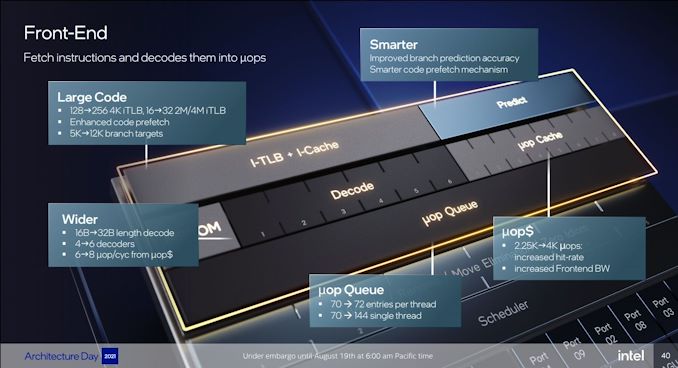
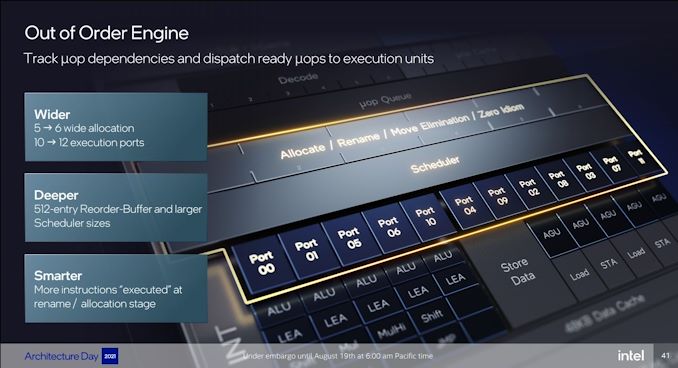
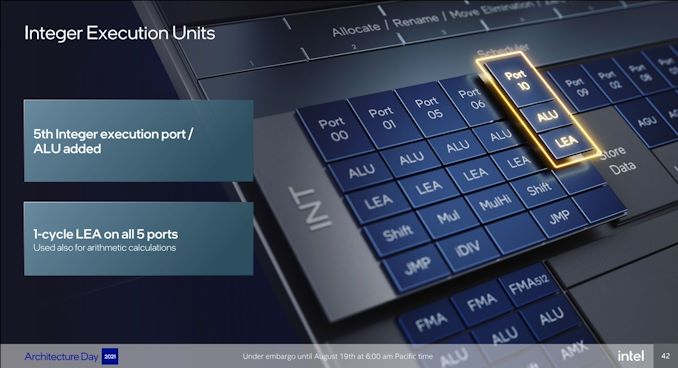

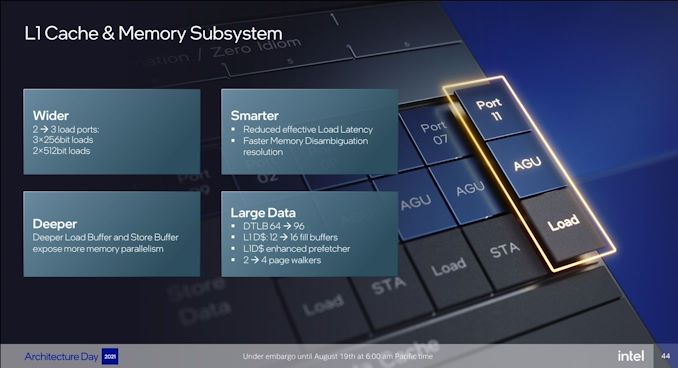
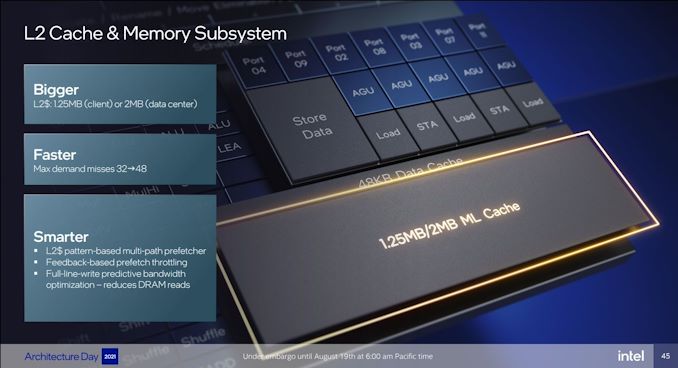
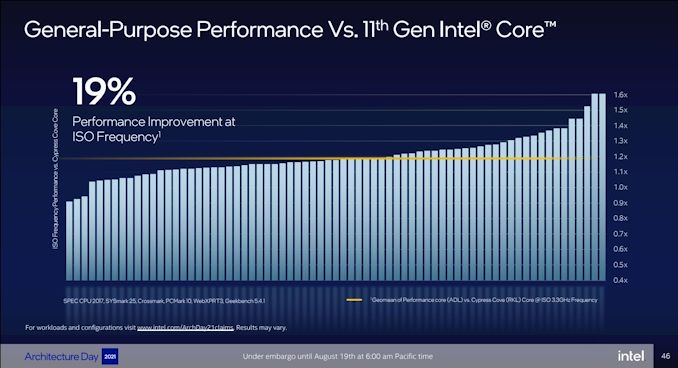








223 Comments
View All Comments
GreenReaper - Friday, August 20, 2021 - link
Intel Threat Detected!ifThenError - Friday, August 20, 2021 - link
LOL!Underrated comment
mode_13h - Saturday, August 21, 2021 - link
:Ddiediealldie - Thursday, August 19, 2021 - link
I'm quite curious how their E-cores are designed. They somehow use 6-way decoder which is same width compared to P-cores. And use twice bigger I-cache, yet using 1/4 of area.Maybe it's related to design philosophy? or Atom team's a true trump card of the Intel design team?
name99 - Thursday, August 19, 2021 - link
That "6-way decoder" is typical Intel double-talk. What is done is that you have two decoders that can each decode three instructions. This works IF there is a branch between the two sets of instructions, because the branch landing point provides a resync point for the second decoder, so the two can run in parallel.You could obviously extend this, in a decent Next Fetch Predictor system, to have the NFP store the lengths of each instruction in the run of instructions to be decoded, and get trivial parallel decode. And Andy Glew (I think it was him, either him or Jim K) submitted a patent for this around 2000. But in true Intel fashion, nothing seems to have been done with the idea...
GeoffreyA - Saturday, August 21, 2021 - link
If I'm not mistaken, Tremont or Goldmont, can't remember which, began marking the instruction boundaries in cache.name99 - Saturday, August 21, 2021 - link
Doing it in the cache is more difficult. Of course it makes the most sense! But it hits the problem that, *in theory*, you can have stupid code that jumps into the middle of an instruction and starts decoding the alternative version of the byte stream that results.This is, of course, absolutely insane, but it's part of the joy that is supporting x86.
Now one way to handle this is to tag the boundaries not in the I-cache (where you can jump to any byte) but in structures that are already set up to deal with instruction streams (as opposed to byte streams). Hence the Next Fetch Predictor, as I described, or in a trace cache if you are using that.
Another solution would be yet another predictor! Assume most code will be sane, but have a separate pool of decoders that are validating the byte stream as opposed to the high-speed instruction stream going through main path of the CPU. In the event of a mismatch
- treat it like a branch misprediction, flush and restart AND
- train the predictor that for this particular cache line, we have to decode slowly and surely
Now why doesn't Intel do any of these things? You and I can think of them, just as people like Andy Glew were thinking of variants of them 20 years ago.
My primary hypothesis is that Intel has become locked into the idea that GHz is everything. Sure they occasionally say they don't believe this, or even claim to have reformed after a disaster (*cough* Pentium4 *cough*) but then they head right back to the crack house.
I suspect it's something like the same mentality as the US Air Force -- when pilots form the highest levels of command, they see pilots as the essence of what the Air Force IS; drones and UAV's are a cute distraction but will never be the real thing.
Similarly, if you see GHz as the essence of what Intel is, that smarts are cute but real men work on GHz, then you will always be sacrificing smarts if they might cut into GHz. But GHz costs the problems we see in the big cores: the crazy power draws, and the ridiculously low density...
Well, this is getting into opinion, not technology, so interpret it as you wish!
GeoffreyA - Sunday, August 22, 2021 - link
Looking at the article again, I see their on-demand instruction length decoder is where this is happening. Seems to be caching lengths after they're worked out. I also wonder if this is why Atom hasn't had a uop cache as yet. It's either that or the length caching, because the uop cache will indirectly serve that purpose as well (decoded instructions don't need their lengths worked out). So it's perhaps a matter of die area here that Intel chose that instead of a uop cache.GeoffreyA - Sunday, August 22, 2021 - link
It's been said that K7 to Bulldozer also did a similar thing, marking instruction boundaries in the cache. And the Pentium MMX, but need to double check this one.mode_13h - Sunday, August 22, 2021 - link
> In the event of a mismatch - treat it like a branch misprediction, flush and restartYes, because even assembly language doesn't make it easy to jump into the middle of another instruction. IMO, any code which does that *deserves* to run slowly, so that it will get replaced with newer software that's written in an actual programming language.
> My primary hypothesis is that Intel has become locked into the idea that GHz is everything.
I think they just got lulled into thinking it was enough to deliver modest generational gains. Anything more ambitious probably jeopardized the schedule or risked their profit margins due to the cores getting to big and expensive. And when time comes for more performance, they reach into their old playbook and go with a "sure" win, like wider vectors. I wonder if the example of TSX reveals anything about their execution, on the more innovative stuff. Because that doesn't build a lot of confidence for taking on bold, new ideas.
> when pilots form the highest levels of command,
> they see pilots as the essence of what the Air Force IS
Not just pilots, but specifically fighter pilots. So, they also don't care much about bombers or Space Command (now Space Force). The only way to change that would be to make them care, by making them more accountable for the other programs, until they realize they need them to be run by someone who know about that stuff. Either that or just reorg the whole military. That would probably also help reign in defense spending.